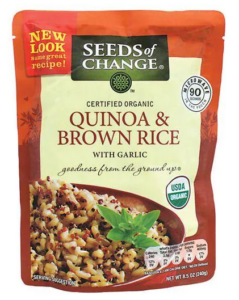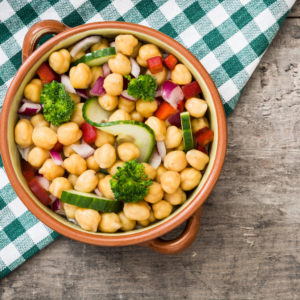By Claire Bacon, ACN, CNC
We all have different reasons for eating the way we do. Vegetarians choose to eat only plant sources of protein because they believe it’s a healthier choice: better for the planet and better for humans. There’s no doubt, it’s better for the animals, too!
There is no perfect diet for everyone. There can be certain pitfalls to trying out all the healthy diets.
The challenge for Vegetarians is to consume a wide variety of plant protein sources, in order to obtain all 9 Essential Amino Acids. If we want to be strong and resilient, amino acids are the key nutrient that might be lacking in a vegetarian diet. Certain amino acids are termed ‘essential’ because they cannot be formed within the body from other sources, and must be consumed from a variety of protein foods in the diet.
Each one of these specific types of proteins has a unique purpose in the body.
Here are the 9 Essential Amino Acids:
| Histidine – precursor to histamine, involved in immune function | Phenylalanine – precursor to dopamine, adrenaline, and tyramine | Lysine – growth and tissue repair, immune function, collagen precursor |
| Isoleucine – helps with blood sugar regulation and energy production | Threonine – supports the nervous system, helps to regulate liver fat | Methionine – source of sulfur to maintain hair and skin, helps absorption of zinc and selenium |
| Leucine – blood sugar regulation and production of growth hormone | Tryptophan – precursor for serotonin, helps with mood and sleep | Valine – supports muscle growth, nervous system, and cognitive health |
Top food sources include:
Grains and Pseudograins:
Buckwheat – contains all essential amino acids, especially lysine, and is gluten-free. Also a good source of B vitamins and rutin. Cooked buckwheat can be can be served as a hot breakfast cereal or added to soups and stews. You can also buy buckwheat in flour form and blend it with other flours to make healthier breads, muffins, and pancakes.
Quinoa – is a pseudograin and is gluten-free. It is a source of all the essential amino acids, especially lysine. It is best when cooked in broth and served alongside vegetables, or topped on a salad.
Rice – is an incomplete source of amino acids, and so is well paired with beans. White rice has the husk, bran, and germ removed, which lowers its nutrients. Brown rice only has the husk removed, so it retains fiber and germ, which contain vital nutrients. Brown rice is a decent source of Leucine, Phenylalanine and Valine, but relatively low in other essentials.

Seitan – is a dense, chewy vegan protein made from wheat gluten. Seitan contains 8 of the 9 essential amino acids, only lacking in lysine. Therefore, it works well to combine with foods high in lysine, such as lentils, tofu, and almonds. We generally don’t recommend that anyone consume gluten. However, if it is imported and organic, it potentially can be a very healthy food.
Ezekial bread (sprouted wheat, barley, beans, lentils, millet and spelt) – Sprouting reduces the gluten content, breaks down enzyme inhibitors, and makes the bread easier to digest. Ezekial bread contains all 9 essential amino acids. Again, we generally don’t recommend that people consume American bread, because the gluten and glyphosate content are so inflammatory. You may like to keep a bottle of Gluterase on hand to ease your digestion!
Beans and Legumes:
Beans – contain particularly high concentrations of tryptophan, isoleucine and phenylalanine, but are low in methionine. They provide a good balance of amino acids when consumed with rice. Soybeans, kidney beans, and navy beans are among the best beans with good amino acid profiles. Surprisingly, lima beans are really not very good in comparison!
Chickpeas – contain 8 of the 9 essential amino acids, only missing histidine. Chickpeas can be paired with foods naturally high in histidine, such as bananas and grapes, and to a lesser extent in root vegetables.

Lentils (red, brown) – are rich in isoleucine and lysine, but are usually low in methionine and cysteine. However, if lentils are sprouted before they are cooked, then all essential amino acids are available. Alternatively, pair lentils with whole grains such as rice or wheat to improve the amino acid profile.
Pea protein – contains all 9 essential amino acids, although is lower in content in tryptophan and methionine.
Nuts and Seeds:
Nut and Seed butters (peanut, almond, cashew, sunflower seed) – are high in 7 of the 9 essential amino acids, with lower amounts of methionine and phenylalanine. They are pretty close to being the perfect vegetarian protein. Therefore, nuts and seeds can be paired well with grains and soy.
Hemp seeds – are considered to be a complete protein source, containing all the essential amino acids, particularly methionine and cysteine. They are also a rich source of healthy fats like Omega 6, Omega 3 and GLA.

Chia seeds – contain all 9 essential amino acids, and are especially high in Omega 3 fatty acids. Chia seeds should be soaked prior to consuming, because they can absorb a substantial amount of water from within the gut.
Other:
Spirulina (algae) – is a type of blue-green algae that grows naturally in oceans and salty lakes in subtropical climates. Spirulina contains all 9 essential amino acids, although is not a particularly good source of methionine or cysteine.

Protein Supplements:
If it is too challenging to consume a variety of these vegetarian foods regularly, we recommend taking either BodyHealth Perfect Amino, Standard Process Protefood, or Biotics AminoSport supplements.
Dr. Bacon can help determine which product is best for you!


